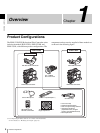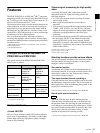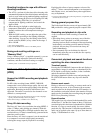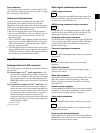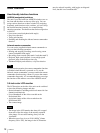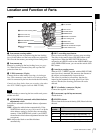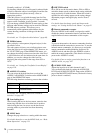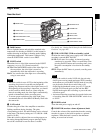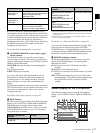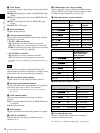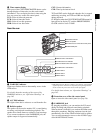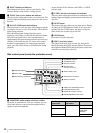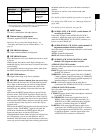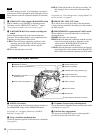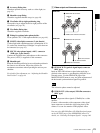
16
Location and Function of Parts
Chapter 1 Overview
g ALARM (alarm tone volume adjustment) knob
Controls the volume of the warning tone that is output via
the built-in speaker or optional earphones. When the knob
is turned to the minimum position, no sound can be heard.
h LCD monitor
Displays camera video, VDR-related warnings, remaining
battery capacity, remaining disc space, audio levels, time
data, and so on.
For details, see “Status Display on the LCD Monitor” on
page 17.
i MENU switch
When flicking toward ON, the menu is displayed. When
flicking toward STATUS, the status of the camcorder (of
current settings) is displayed.
For details, see “Displaying Menus” on page 131.
j WHITE BAL (white balance memory) switch
Controls adjustment of the white balance.
PRST: Adjusts the color temperature to the preset value
(the factory default setting: 3200K). Use this setting
when you have no time to adjust the white balance.
A or B: Recall the white balance adjustment settings
already stored in A or B.
Press the AUTO W/B BAL switch (see page 13) on
the WHT side, to automatically adjust the white
balance, and save the adjustment settings in memory
A or memory B. The 5600K button does not function.
You can use the AUTO W/B BAL switch even when
ATW
1)
is in use.
B (ATW): When this switch is set to B and WHITE
SWITCH <B> is set to ATW on the WHITE
SETTING page of the MAINTENANCE menu, ATW
is activated. When this switch is adjusted, the new
setting appears on the setting change/adjustment
progress message display area of the viewfinder
screen for about 3 seconds. You can assign the ATW
function to an ASSIGN switch on the ASSIGNABLE
page of the OPERATION menu.
For details about how to assign the function to an ASSIGN
switch, see “Assigning Functions to ASSIGN Switches” on
page 142.
1) ATW (Auto Tracing White Balance): The white balance of the picture
being shot is adjusted automatically for varying lighting conditions.
k OUTPUT/DCC (output signal/dynamic contrast
control) switch
Switches the video signal, which is output to the video disc
drive (referred to as “VDR”), viewfinder, and video
monitor from the camera section, between the following
two.
BARS: Outputs the color bar signal.
CAM: Outputs the video signal from the camera. When
this is selected, you can switch DCC
1)
on and off.
1) DCC (Dynamic Contrast Control): Against a very bright background
with the iris opening adjusted to the subject, objects in the background will
be lost in the glare. The DCC function will suppress the high intensity and
restore much of the lost detail and is particularly effective in the following
cases.
• Shooting people in the shade on a sunny day
• Shooting a subject indoors, against a background through a window
• Any high contrast scene
LCD monitor operating buttons
a DISPLAY/EXPAND button
Each time pressing this button, the display in the LCD
monitor changes as follows.
ALARM
Minimum Maximum
OUTPUT
DCC
CAMBARS
ONOFF
OUTPUT: BARS, DCC: OFF
A color bar signal is output and the DCC circuit does not
operate. Use this setting to adjust the video monitor, to
record the color bar signal, etc.
OUTPUT: CAM, DCC: OFF
The video signal from the camera is output, and
the DCC circuit does not operate.
OUTPUT: CAM, DCC: ON
The video signal from the camera is output, and
the DCC circuit operates.
1 DISPLAY/EXPAND button
2 COUNTER/CHAPTER button
3 RESET button
4 BRIGHT button



